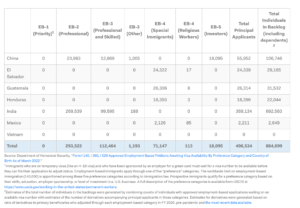Employment-Based Green Card, I-485 Processing Timeline [2023]
Getting an employment-based green card can be a long but rewarding process. There are many advantages to using your employment to gain lawful permanent resident status in the U.S., and there are many ways to go about getting this status. One such way is through an adjustment of status through the use of an I-485 form. Keep reading to learn how long you can expect to wait to get a green card via adjustment of status and what goes into the employment-based green card timeline as a whole.
As per the Immigration and Nationality Act, adjustment of status from a nonimmigrant visa to an immigrant visa (aka green card) is only possible if the beneficiary meets all of the necessary requirements for permanent residence. Understanding what makes someone eligible for a green card will help you determine what your timeline will be in obtaining one.
Benefits of Employment-Based Adjustment of Status
There are many benefits if you’ve reached the employment-based adjustment of status phase. In particular, this is the final step before actually receiving your green card. Unlike other categories, like family-based immigration, which require an interview, once your adjustment of status application is approved, you’re usually ready to go.
Simultaneously Apply for Advance Parole
The second benefit of an employment-based adjustment of status is the ability to simultaneously apply for advance parole. Essentially, advanced parole permits you to reenter the U.S. without an immigrant/non-immigrant visa after traveling overseas. It also protects your pending AOS application from being considered abandoned. This is very advantageous since the interim waiting period for some employment-based green card timelines can span several years.
Apply for an Employment Authorization Document
Another benefit of an employment-based adjustment of status is the ability to file for an EAD. This document allows you to work legally in the U.S. for a temporary period (typically a year). To do so you will need to file an I-765 for a work permit. Applications for employment authorization usually take up to 90 days before a decision is made by the USCIS. Learn more about Employment Authorization Documents.
Change Employers After Filing
If your I-485 petition is sponsored by an employer, for instance, some EB-1 green cards, EB-2, or EB-3, you have the option to change employers six months after the adjustment of status has been filed. The only exception is if your EB-2 is filed under a national interest waiver (NIW).
Green Card Processing Time – PERM
The PERM is made up of several steps which can range in the amount of time it takes to get through each one.
- The initial recruitment period must last for a minimum of 30 days.
- After this, your employer will have to wait an additional 30 days to allow an appropriate number of candidates to apply.
- Then your employer will need to conduct interviews with qualified candidates to ensure that you are not displacing any U.S. workers. If all goes well, and there are no qualified candidates for your position, then it may take as little as six months after that to process your PERM.
However, there are two major hiccups that can delay this process. The first is an audit by the Department of Labor. There are two kinds of audits: random and targeted. You can’t avoid random audits, but following the required rules and keeping everything above the board can help your employer avoid targeted ones. During an audit, your employer will have to send all documents and receipts regarding the recruitment process to the DOL. This can add as many as nine months to the processing time.
The second obstacle is the supervised recruitment. If your employer has a history of receiving targeted audits or attempting to circumvent the system, they may be subjected to supervised recruitment. If this is the case, your employer will have to go through the recruitment process with a DOL certifying officer working alongside every step. Avoid attempting to cheat the PERM process to steer clear of supervised recruitment. If your application is audited, the processing time may be extended up to 18 months.
Check out the Family-Based Green Card Processing Time Up-To-Date Statistics.
Employment-Based Green Card Timeline
The employment-based green card timeline varies depending on the category you qualify for. Generally, however, here are the steps you need to take if you are working toward getting an employment-based green card:
Have a U.S. Employer
Unless you qualify for the EB-1A green card or EB-2 NIW that allows you to self-petition, you will need to have a U.S.-based employer to sponsor your petition. You will either ask your employer to sponsor you for a green card or find a different employer who is willing to do so. Also, remember that not all job positions qualify for a green card. If you are already on a nonimmigrant work visa, you may also need to change your job position before you begin the application process. Your immigration attorney is in the best position to guide you on this.
Complete PERM Labor Certification Process: Average of Six to Nine Months
Once you have a qualifying job offer and an employer who is ready to sponsor your green card, the next step is to complete the Program for Electronic Review Management (PERM) Labor certification. This is a process that requires your employer to demonstrate that the foreign worker (you) is not taking a job position away from qualified U.S. workers.
Your employer will need to obtain a PERM Labor Certification on your behalf. This involves a recruitment process to ensure that you are not displacing any qualified U.S. workers. However, a PERM is not required for the EB-1 green card or the EB-2 with a National Interest Waiver.
The PERM can take between six months and a year and a half to obtain depending on whether or not your employer is subjected to an audit. Here is the breakdown of the timeline for PERM Labor processing times:
- Prevailing Wage Request: two weeks
- Recruitment Process: eight to nine weeks
- ETA-9089 Application: 24 weeks
At the time of writing this post, the fastest PERM processing time including the job ad, the prevailing wage determination (PWD) and I-140 in Premium Processing is 1 year, 3 months, 28 days. With the I-140 in regular processing, the total timeline is 1 year, 11 months and three days. Data shows that the fastest PERM audit alone takes 10 months and 24 days while the fastest prevailing wage determination alone takes 6 months, 21 days. The processing time is quite accurate as of today.
Complete the I-140, Immigrant Petition for Alien Worker
After your employer successfully completes your PERM Labor certification process, the next step is for your employer to file an I-140 petition on your behalf. The purpose of the I-140 is to demonstrate that you meet all the job requirements on the PERM application and to verify that your employer has the financial ability to pay you the prevailing wage for the position.
The timeline for the I-140 will depend on whether your employer is using the regular processing or premium processing service. Regular processing for the I-140 typically takes an average of six to nine months to process. On the other hand, premium processing will only take 15 calendar days. The good news is that many U.S. employers prefer premium processing, which will expedite the overall processing time. Once the USCIS receives the petition, that date will be your priority date. You must wait until your priority date is current with the final action dates posted by the Department of Homeland Security.
The employment-based green card timeline for this stage is dependent on which preference level you qualify for and which country you hold citizenship. Some preference levels have no wait time while others have a wait time of several years. To get a better idea, check the latest Visa Bulletin.
File the I-485, Adjustment of Status Petition
Once your priority date is current, you can file for an Adjustment of Status by submitting an I-485 form. The I-485 is the last stage along the employment-based green card timeline, but in most cases, it has the longest waiting period. While actually processing the form takes an average of six months, there is an annual limit to the number of green cards available to each country.
Source: Department of Homeland Security, “Form I 140, I 360, I 526 Approved Employment Based Petitions Awaiting Visa Availability By Preference Category and Country of Birth As of March 2022.”
Applicants from countries with fewer green card applicants usually have a much shorter waiting time compared to those from countries with a large number of applicants. Due to this, the I-485 waiting time can take several months or even several years. Another factor that may influence the timeline is the workload at the service center in charge of your case.
Get Your Employment-Based Green Card
After your I-485 is approved, the USCIS will issue you an employment-based green card and you will have successfully adjusted your status.
The full employment-based green card timeline can range anywhere from ten months in the best scenarios to several years in the worst scenarios. Your immigration attorney can give you a better idea of what you can expect.
Employment-Based Green Card Types and Process
There are five major categories for employment-based immigrant visas with the three below being the most popular. The timeline will depend on the specific requirements for the category you are seeking. These three categories are:
Known as the first preference employment-based immigrant visa, the EB-1 category is for foreign professionals who possess extraordinary achievements in their fields as well as outstanding researchers and professors.
This is perhaps the most prestigious employment-based green card application, in that it comes with requirements that are not easily obtained. Due to this, few applicants qualify for it. However, if you can meet these requirements, the EB-1 can sometimes have the shortest processing timeline out of all U.S. employment-based green cards depending on your country of origin. It doesn’t require PERM Labor processing and the EB-1A can be self-sponsored without the need for a U.S.-based employer.
Check out this post on EB-1 processing time.
EB-2 for Those with Exceptional Ability or Advanced Degrees
The EB-2, second preference employment-based green card is for applicants who possess advanced degrees or exceptional ability in science, business, or art. It also has a National Interest Waiver option, which allows qualified applicants to circumvent the PERM Labor Certification requirements, provided they can prove it would be in the nation’s best interest to do so.
The EB-2 processing time will depend on whether you are applying for the regular EB-2 or opting for the National Interest Waiver (NIW). If you qualify for the NIW, keep in mind that you will be ineligible for premium processing, likely resulting in a longer wait time.
Check out these EB2 NIW Frequently Asked Questions.
EB-3 Green Card for Skilled Workers, Professionals, or Other Workers
The EB-3 green card covers a wide range of applicants and has less stringent requirements compared to the two categories above. To qualify as a skilled worker, you must demonstrate that you have at least two years of job experience or training in the job you are applying through.
To qualify as a professional, you must have at least a U.S. bachelor’s degree or its foreign degree equivalent in the field you are working in. Other workers are usually unskilled workers who are able to demonstrate the ability to perform unskilled labor that is not seasonal or temporary in nature.
An EB-3 applicant must have a job offer from a U.S. employer and fulfill the PERM Labor Certification requirements, which will likely mean a longer application timeline than other categories where the PERM can be waived.
Employment-Based Green Card Timeline Requirements
In most cases, the following documents are necessary as part of the adjustment of status requirements:
- I-485 Application to Adjust Status
- I-693 Medical Report and Vaccinations
- A copy of I-797 showing that the I-140 has been received and approved by USCIS. Is your priority date current? If so, you can file both the I-485 and I-140 at the same time.
- Copy of approved Labor Certificate
- Employment letter from the employer confirming that the position/job is still available. This letter should be on official employer letterhead and also include details pertaining to the salary.
- Copies of recent pay stubs
- Copy of approved I-140 if not filed concurrently
Note that since some cases require additional paperwork to be filed, it’s best to contact a qualified employment immigration attorney.
How Much Will It Cost?
Aside from the costs involved with obtaining a nonimmigrant visa, which could be substantial, there are a few fees that come along with adjusting your status.20
- I-140 Filing Fee – $700
- I-485 Filing Fee – This fee varies depending on how old you are and whether or not a biometrics service charge is applied. For a full table detailing the costs for the I-485, you can visit the USCIS website.
- Premium Processing Fee – $2,500
Fortunately, the Department of Labor requires no fees for a PERM Labor Certification. However, there may be costs associated with running an ad campaign and recruitment process.
Green Card Interview for Employment-Based Adjustment of Status
While in most cases, the adjustment of status interview is waived for employment-based cases, there are scenarios in which you may receive an interview notice. If this is the case, it’s important that you show up in professional attire and bring the necessary paperwork.
This includes originals of passports, current or expired EAD cards, interview letters, pay stubs, tax returns, transfer notices, permissions to travel (advance parole), etc. Be aware that if any employment-related circumstances have changed since the time of filing it’s imperative to bring the appropriate documents during the interview.
Do I Need To Maintain My Nonimmigrant Status?
There are a few disadvantages in the overall adjustment of status process. One significant drawback is that processing times may not be consistent. Another disadvantage is the risk of having your I-140 denied. For that reason, many recommend that AOS applicants maintain their non-immigrant status until the I-140 is approved.
Premium Processing
Premium processing is an optional service that allows petitioners that are using the I-140 petition for certain visas to expedite the processing times of these petitions from the typical average of six months to just 15 calendar days for an extra fee of $2,500. This involves filing an I-907 Request for Premium Processing.
However, keep in mind that premium processing can only be used for the I-140 petition and is not able to be used with the I-485 or any other form in the employment-based green card timeline. It also does not increase your chances of having your petition approved and it does not affect your priority date waiting time. However, if you are on H-1B status and you would like to reap the benefits of having an approved I-140 filed with the USCIS, premium processing may be for you.
Lastly, premium processing is not available for the EB-1C green card for multinational executives and managers and the EB-2 green card with a National Interest Waiver.
What to Do While Your Employment-Based Green Card Application Is Being Processed by the USCIS
To guard against missing important information while your green card application is pending with the USCIS, you need to observe the following instructions:
Update Your Address
If you move to a new place after submitting your application, you will need to update your address with the USCIS. You may not get important notices about your application if you fail to do this. This USCIS “Change of Address Information webpage” has the full details on how to update your address.
Check Your Case’s Status
You can always check this USCIS Processing Time Information webpage to know how long it will take for your I-485 to be processed.
Travel Precautions
If you need to travel outside the U.S. while your employment-based green card application is pending, you will need to apply for an I-131, otherwise known as an Application for Travel Document. Without this, you may be considered to have abandoned your application and may forfeit the entire green card application process.

![Employment-Based Green Card, I-485 Processing Timeline [2023] Employment-Based Green Card, I-485 Processing Timeline [2023]](https://www.immi-usa.com/wp-content/uploads/2020/06/Benefits-of-Employment-Based-Adjustment-of-Status-300x225.png)





